
- Home
- Travel Packages
- Top Destination
-
Travel Attraction
By Category
Top Attraction

- Travel Agents
- Car Rentals
- Hotels
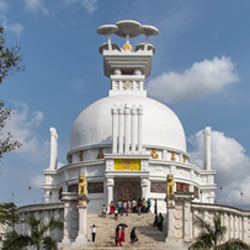
About Dhauli Hill, Bhubaneswar History Dhauli Hill in Bhubaneswar, Odisha, is a significant historical site that holds immense importance in Indian history. It is the location where the Kalinga War took place in 261 BC, resulting in a significant transformation in Emperor Ashoka’s life. After witnessing the devastating effects of war, Ashoka renounced violence and embraced Buddhism, leading to the spread of this peaceful religion across India. Architecture and Design The hill is adorned with a rock edict of Ashoka, depicting his conversion to Buddhism and his message of non-violence. The Shanti Stupa at Dhauli Hill is a prominent structure, symbolizing peace and harmony. The architectural design of the stupa showcases the influence of Buddhist art and culture, making it a serene and spiritually uplifting place for visitors. Best Time to Visit The best time to visit Dhauli Hill is during the winter months, between October and February. The weather during this time is pleasant, making it easier for tourists to explore the site comfortably. Additionally, the lush green surroundings of Dhauli Hill are at their most vibrant during the winter, creating a picturesque setting for visitors to enjoy. Cultural Significance Dhauli Hill holds immense cultural significance as it marks the beginning of Emperor Ashoka’s journey towards peace and non-violence. The site serves as a reminder of the destructive consequences of war and the importance of embracing compassion and harmony. The influence of Buddhism can be felt strongly at Dhauli Hill, making it a sacred place for followers of this peaceful religion. Pilgrimage Practices Pilgrims visiting Dhauli Hill often engage in spiritual practices such as meditation and prayer. They pay homage to Emperor Ashoka and seek blessings for peace and enlightenment. The peaceful ambiance of the hill makes it an ideal place for introspection and spiritual reflection, allowing pilgrims to connect with their inner selves and find solace in the teachings of Buddhism. Dress Code and Etiquette Visitors to Dhauli Hill are advised to dress modestly and respectfully, keeping in mind the sacred nature of the site. It is recommended to wear comfortable clothing and remove footwear before entering the Shanti Stupa or any other religious structures. Silence and reverence are expected from visitors to maintain the sanctity of the place and respect the spiritual beliefs of others. Activities and Experiences Visitors to Dhauli Hill can engage in a variety of activities and experiences, including exploring the rock edicts of Emperor Ashoka, admiring the intricate carvings on the Shanti Stupa, and enjoying panoramic views of the surrounding landscapes. Cultural events and festivals are also held at Dhauli Hill, providing visitors with an opportunity to immerse themselves in the rich heritage and traditions of Odisha. Art and Religious Symbols The art and religious symbols at Dhauli Hill reflect the spiritual heritage of Buddhism and the teachings of Emperor Ashoka. Intricate carvings, sculptures, and inscriptions adorn the site, depicting scenes from the life of Buddha and the message of peace and non-violence. The Shanti Stupa, in particular, is a masterpiece of Buddhist art, symbolizing the eternal quest for harmony and tranquility. Local Insights Local residents and guides offer valuable insights into the history and significance of Dhauli Hill, sharing stories and legends associated with the site. Visitors can learn about the cultural traditions of Odisha and the impact of Buddhism on the region, gaining a deeper understanding of the spiritual heritage that Dhauli Hill represents. Engaging with locals provides a unique perspective on the site and enhances the overall experience of exploring this sacred place.
Explore More
Nestled in an inner fold of the Sahyadri hills, 100 kms away from Aurangabad are the 30 rock-cut caves of Ajanta, famous for its cave painting or frescoes of many colors. They contain numerous images of Buddha. Caves 1,2,16 and 17 have the best-preserved paintings. The magnificient depictions of the bodhisattvas Avalokitesvara and Padmapaniin are particularly well known. The Ajanta Caves are a World Heritage site cut from the volcanic lava of the Deccan in the forest ravines of the Sahyadri Hills. They are set in beautiful sylvan surroundings, providing a unique combination of architecture, sculpture and paintings.
Explore More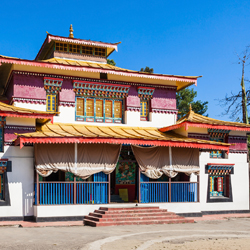
About Enchey Monastery The Enchey Monastery, located in Gangtok, Sikkim, is a prominent Buddhist monastery that holds great religious significance for the local community. It is known for its serene surroundings and peaceful ambiance, making it a popular destination for spiritual seekers and tourists alike. Architectural Facts The Enchey Monastery is a beautiful example of traditional Tibetan architecture, with intricate wood carvings and colorful murals adorning its walls. The main shrine houses a statue of Buddha along with other deities, and the prayer hall is adorned with prayer flags fluttering in the wind. History Founded in the 19th century, the Enchey Monastery has a rich history tied to the Nyingma school of Tibetan Buddhism. It is believed to be built on a site blessed by Lama Druptob Karpo, a revered sage who meditated at the location. Location The Enchey Monastery is located just 3 kilometers from Gangtok city center, making it easily accessible for visitors. The monastery is nestled amidst lush greenery and offers stunning views of the surrounding mountains. Visiting Hours The Enchey Monastery is open to visitors from 6 am to 4 pm every day, allowing ample time for exploration and prayer. It is recommended to visit early in the morning to experience the monks' chanting prayers. Gurudwara Services and Events The Enchey Monastery hosts special events and festivals throughout the year, including the annual Cham Dance festival that attracts devotees from far and wide. Additionally, the monastery offers weekend retreats and meditation sessions for those seeking spiritual guidance. Regarding timings, the monastery is open on weekends, providing visitors with the opportunity to participate in religious services and learn more about Tibetan Buddhism. Accessibility and Directions Visitors can reach the Enchey Monastery by car or public transport, with ample parking available near the entrance. The monastery is wheelchair accessible, ensuring that all visitors can explore its sacred grounds comfortably. Visitor’s Information Entry to the Enchey Monastery is free of charge, but donations are welcome to support the upkeep of the monastery. Visitors are advised to dress modestly and remove their shoes before entering the prayer hall as a sign of respect. Guides are available for those who wish to learn more about the monastery's history and significance. Nearby Attractions While visiting the Enchey Monastery, visitors can explore other nearby attractions such as the Namgyal Institute of Tibetology, Tsomgo Lake, and the Rumtek Monastery. These sites offer further insight into Tibetan culture and history, making for a fulfilling and educational journey. Best Time to Visit The best time to visit the Enchey Monastery is during the months of October to December when the weather is pleasant and clear, offering stunning views of the Himalayan mountains. The monastery's annual festivals and events also take place during this time, providing a unique cultural experience for visitors.
Explore More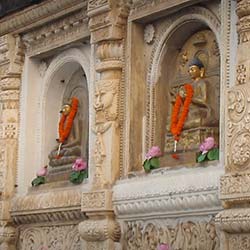
About Mahabodhi Temple, Bodhgaya Bodhgaya, located in the state of Bihar, India, is famous as the place where Prince Siddhartha Gautama attained enlightenment and became the Buddha. The Mahabodhi Temple in Bodhgaya is a UNESCO World Heritage Site and is considered one of the holiest Buddhist pilgrimage sites in the world. History, Architecture, and Design The Mahabodhi Temple was originally built by Emperor Ashoka in the 3rd century BC to commemorate the Buddha's enlightenment. The current temple, however, dates back to the 5th-6th century AD and is a fine example of Indian brickwork and sculptural art. The architecture reflects a blend of Indian, Chinese, and Burmese styles, with a central tower rising to a height of 55 meters. Best Time to Visit The best time to visit the Mahabodhi Temple is during the winter months from October to March when the weather is pleasant and conducive for exploring the complex. Avoid visiting during the summer months as the temperatures can soar and make sightseeing uncomfortable. Cultural Significance The Mahabodhi Temple holds immense cultural significance as the place where the Buddha achieved enlightenment. It is a sacred site for Buddhists around the world and attracts pilgrims and tourists alike. The temple complex also houses a sacred Bodhi tree, which is believed to be a direct descendant of the tree under which the Buddha meditated. Pilgrimage Practices Pilgrims visiting the Mahabodhi Temple often perform rituals such as circumambulating the temple, offering prayers, and meditating under the Bodhi tree. It is a place for reflection, meditation, and seeking spiritual enlightenment. Pilgrims also offer flowers, incense, and candles as offerings to the Buddha. Dress Code and Etiquette Visitors are required to dress modestly and respectfully when visiting the Mahabodhi Temple. Avoid wearing revealing clothing or shorts, and remember to remove your shoes before entering the temple complex. Silence and respect for the sacredness of the site are also important. Activities and Experiences Visitors to the Mahabodhi Temple can participate in meditation sessions, attend Buddhist teachings, and explore the temple complex and its surrounding gardens. The temple also hosts various cultural events and ceremonies throughout the year, providing visitors with a rich and immersive experience. Art and Religious Symbols The Mahabodhi Temple is adorned with intricate carvings, sculptures, and reliefs depicting scenes from the life of the Buddha and various Buddhist deities. The temple's architecture and design are rich in symbolism and serve as a visual representation of Buddhist beliefs and teachings. Local Insights Locals in Bodhgaya are deeply connected to the Mahabodhi Temple and often participate in the daily rituals and ceremonies held at the site. Visiting during festivals such as Buddha Purnima or the Dalai Lama's teachings can provide a unique insight into the local culture and traditions. Interacting with locals and attending local events can enhance your overall experience of Bodhgaya.
Explore More
About the Bodhi Tree, Bodhgaya History The Bodhi Tree in Bodhgaya is believed to be the exact spot where Siddhartha Gautama, the Buddha, attained enlightenment over 2,500 years ago. The tree is a descendant of the original tree under which the Buddha meditated. It has since become a sacred site for Buddhists from around the world. Architecture and Design The Bodhi Tree is a majestic fig tree that stands within the Mahabodhi Temple complex. The temple itself is a magnificent example of ancient Indian architecture, with intricate carvings and sculptures depicting the life of the Buddha. The tree is surrounded by a low fence to protect its roots, and devotees can meditate under its branches. Best Time to Visit Cultural Significance The Bodhi Tree is considered one of the most important Buddhist pilgrimage sites in the world. It symbolizes the Buddha's enlightenment and serves as a focal point for meditation and prayer. Pilgrims from all over the world come to Bodhgaya to pay their respects to the tree and seek spiritual enlightenment. Pilgrimage Practices Visitors to the Bodhi Tree often participate in traditional Buddhist rituals, such as offering incense, flowers, and prayers. Many pilgrims also choose to circumambulate the tree, walking in a clockwise direction as a sign of respect. Some may spend hours meditating under the tree, seeking inner peace and enlightenment. Dress Code and Etiquette When visiting the Bodhi Tree, it is important to dress modestly and respectfully. Both men and women should cover their shoulders and legs, and remove shoes before entering the temple complex. Silence and mindfulness are encouraged, as the site is considered a place of contemplation and spiritual reflection. Activities and Experiences Art and Religious Symbols The Bodhi Tree and the Mahabodhi Temple are adorned with intricate carvings and statues that depict scenes from the life of the Buddha. These artistic representations serve as a visual reminder of the teachings of Buddhism and the importance of enlightenment. The tree itself is a living symbol of growth and transformation. Local Insights Local guides and monks are often available to provide insight into the history and significance of the Bodhi Tree. They can offer spiritual guidance and answer questions about Buddhist practices and beliefs. Visitors can also explore the nearby villages and markets to experience local culture and cuisine, gaining a deeper understanding of the region's traditions and way of life.
Explore More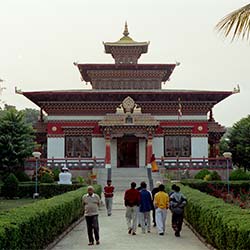
About the Chinese Temple in Bodhgaya History, Architecture, and Design The Chinese Temple in Bodhgaya, also known as the Indosan Nippon Japanese Temple, is a peaceful and beautifully designed structure that serves as a place of worship and meditation for Buddhist practitioners. The temple was built in the 1970s with contributions from various countries, including China, Japan, and India. The architecture of the temple blends traditional Chinese and Japanese design elements, creating a unique and tranquil space for visitors to explore and reflect. Best Time to Visit The best time to visit the Chinese Temple in Bodhgaya is during the winter months, from October to March, when the weather is cool and pleasant. This time of year is ideal for exploring the temple grounds and participating in meditation and prayer sessions without the heat and humidity of the summer months. Cultural Significance The Chinese Temple holds great cultural significance for Buddhists around the world, as it is located in Bodhgaya, the site where Siddhartha Gautama, the Buddha, attained enlightenment. The temple is a place of pilgrimage and spiritual retreat for those seeking to deepen their connection to the teachings of Buddhism and honor the historical importance of Bodhgaya. Pilgrimage Practices Many Buddhists visit the Chinese Temple in Bodhgaya as part of a pilgrimage to important Buddhist sites in India. Pilgrims often participate in meditation, prayer, and ritual practices at the temple, seeking spiritual renewal and enlightenment. Visiting the temple is a way for Buddhists to connect with the teachings of the Buddha and deepen their understanding of the path to enlightenment. Dress Code and Etiquette Visitors to the Chinese Temple in Bodhgaya are expected to dress modestly and respectfully, covering their shoulders and knees. It is customary to remove your shoes before entering the temple and to conduct yourself quietly and respectfully while on the temple grounds. It is important to follow the instructions of temple staff and to avoid taking photographs in areas where it is prohibited. Activities and Experiences Visitors to the Chinese Temple in Bodhgaya can participate in a variety of activities and experiences, including meditation sessions, prayer ceremonies, and cultural performances. The temple grounds offer a peaceful and serene environment for contemplation and reflection, with beautiful gardens and ornate statues that create a sense of tranquility and spiritual connection. Art and Religious Symbols The Chinese Temple is adorned with beautiful artwork and religious symbols that hold deep significance for Buddhist practitioners. Intricate carvings, colorful murals, and statues of Buddhas and Bodhisattvas can be found throughout the temple, creating a visually stunning and spiritually inspiring environment for visitors to explore and appreciate. Local Insights Local residents and monks in Bodhgaya provide valuable insights and perspectives on the Chinese Temple, sharing the history and significance of the temple as well as offering guidance on how to best experience and appreciate the spiritual and cultural aspects of the site. Engaging with locals can enhance your visit to the temple and deepen your understanding of the Buddhist traditions and practices that are observed there.
Explore More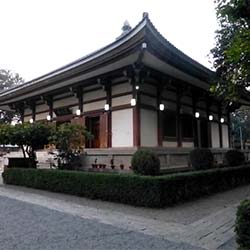
Indosan Nippon Japanese Temple
About Indosan Nippon Japanese Temple, Bodhgaya History The Indosan Nippon Japanese Temple, also known as the Japanese Buddhist Temple, is a tranquil sanctuary located in Bodhgaya, India. The temple was built in 1972 by the Japanese Buddhist monk Nichidatsu Fujii, in collaboration with Indian and Japanese governments. It serves as a symbol of the strong cultural and religious ties between Japan and India. Architecture and Design The Indosan Nippon Japanese Temple features traditional Japanese architectural elements such as a pagoda-style roof, wooden lattice windows, and intricate carvings. The serene garden surrounding the temple adds to its peaceful ambiance and makes it a perfect place for meditation and reflection. Best Time to Visit The best time to visit the Indosan Nippon Japanese Temple is during the winter months from October to March when the weather is pleasant and ideal for exploring the temple grounds. Avoid visiting during the summer months as the temperatures can be scorching hot. Cultural Significance The Japanese Buddhist Temple holds great cultural significance as a place of worship and spiritual practice for followers of Buddhism. It is a sanctuary for pilgrims seeking enlightenment and inner peace, and a symbol of the enduring friendship between Japan and India. Pilgrimage Practices Pilgrims visiting the Indosan Nippon Japanese Temple often engage in meditation, chanting, and offering prayers at the temple. It is a sacred place where devotees can connect with their spiritual beliefs and seek guidance on their path to enlightenment. Dress Code and Etiquette Visitors are required to dress modestly and remove their shoes before entering the temple premises as a sign of respect. It is important to maintain silence and avoid any disruptive behavior while inside the temple to ensure a peaceful environment for meditation and prayer. Activities and Experiences Visitors to the Indosan Nippon Japanese Temple can participate in meditation sessions, attend prayer ceremonies, and explore the beautiful garden surrounding the temple. The serene atmosphere of the temple provides a perfect setting for spiritual contemplation and relaxation. Art and Religious Symbols The temple is adorned with various religious symbols and artwork that represent Buddhist teachings and concepts. Intricate carvings, paintings, and sculptures can be found throughout the temple, creating a visually stunning and spiritually inspiring environment for visitors. Local Insights Local residents and guides can provide valuable insights into the history and significance of the Indosan Nippon Japanese Temple, offering a deeper understanding of its cultural and religious importance. Engaging with the local community can enrich the overall experience of visiting this sacred site.
Explore More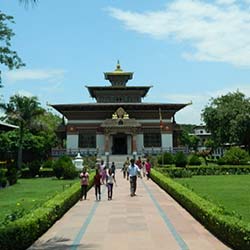
About Royal Bhutan Monastery, Bodhgaya The Royal Bhutan Monastery in Bodhgaya is a beautiful and serene place of worship that holds cultural significance for the Bhutanese people. Its rich history, unique architecture, and peaceful surroundings make it a must-visit destination for those seeking spiritual enlightenment. History The Royal Bhutan Monastery was established in 2003 by the Kingdom of Bhutan as a gift to the Mahabodhi Society of India. It was built to promote peace and harmony among all beings and to honor the teachings of Lord Buddha. The monastery serves as a symbol of the strong bond between Bhutan and India, as well as a beacon of hope for all who seek enlightenment. Architecture and Design The Royal Bhutan Monastery is a stunning example of traditional Bhutanese architecture, with intricate wood carvings, colorful paintings, and ornate decorations. The main temple is adorned with a gold-plated roof and houses a magnificent statue of Buddha. The surrounding gardens and prayer wheels add to the peaceful and meditative atmosphere of the monastery. Best Time to Visit The best time to visit the Royal Bhutan Monastery is during the winter months, from November to February, when the weather is cool and pleasant. This is also the peak tourist season, so you can expect to see the monastery bustling with visitors from all over the world. However, if you prefer a quieter and more peaceful experience, consider visiting during the off-peak months of March to October. Cultural Significance The Royal Bhutan Monastery holds great cultural significance for the Bhutanese people, as it represents their strong ties to Buddhism and their commitment to promoting peace and harmony. The monastery is a place of worship, meditation, and learning, where visitors can immerse themselves in Bhutanese culture and traditions. Pilgrimage Practices Visitors to the Royal Bhutan Monastery are encouraged to participate in traditional pilgrimage practices, such as prostration, circumambulation, and offering prayers and offerings. These practices are believed to purify the mind, body, and soul, and deepen one's connection to the teachings of Buddha. Pilgrims can also receive blessings from the resident monks and take part in special ceremonies and rituals. Dress Code and Etiquette Visitors to the Royal Bhutan Monastery are expected to dress modestly and respectfully, covering their shoulders and knees. Shoes should be removed before entering the temple, and hats and sunglasses should be removed as a sign of respect. Talking loudly, taking photos without permission, and touching or pointing at religious objects are considered disrespectful behaviors and should be avoided. Activities and Experiences Visitors to the Royal Bhutan Monastery can participate in a variety of activities and experiences, such as attending meditation sessions, listening to lectures by resident monks, and taking part in traditional ceremonies and rituals. The monastery also offers guided tours, cultural performances, and workshops on Bhutanese art and handicrafts. Visitors can also explore the surrounding gardens, prayer wheels, and meditation huts for a truly immersive experience. Art and Religious Symbols The Royal Bhutan Monastery is adorned with beautiful art and religious symbols that reflect the rich cultural heritage of Bhutan. Intricate wood carvings, colorful paintings, and ornate decorations depict scenes from the life of Buddha, as well as symbols of peace, wisdom, and compassion. The main temple houses a magnificent statue of Buddha, surrounded by offerings of flowers, candles, and incense. Local Insights Visitors to the Royal Bhutan Monastery can gain valuable insights into Bhutanese culture and traditions by interacting with the resident monks and local devotees. They can learn about the history and significance of the monastery, as well as the daily routines and practices of the monks. Visitors can also explore the nearby villages and markets to experience the local way of life and taste traditional Bhutanese cuisine.
Explore More
About Thai Monastery, Bodhgaya The Thai Monastery in Bodhgaya is a beautiful and serene place of worship for Buddhists from around the world. It holds great historical and cultural significance and is a popular destination for pilgrims seeking spiritual enlightenment. History The Thai Monastery was established in Bodhgaya to commemorate the visit of the King of Thailand in 1956. It was built as a symbol of the strong bond between Thai and Indian Buddhists and serves as a place of meditation and worship for all who visit. Architecture and Design The Thai Monastery features traditional Thai architecture with intricate carvings and colorful decorations. The main hall houses a beautiful statue of the Buddha, surrounded by stunning murals depicting scenes from his life. Best Time to Visit The best time to visit the Thai Monastery in Bodhgaya is during the winter months from November to February when the weather is cooler and more pleasant. This is also the peak season for tourists, so it is advisable to plan your visit in advance. Cultural Significance The Thai Monastery is an important cultural landmark in Bodhgaya, symbolizing the strong ties between Thailand and India. It is a place of spiritual pilgrimage for Buddhists seeking enlightenment and inner peace. Pilgrimage Practices Visitors to the Thai Monastery are encouraged to engage in traditional Buddhist practices such as meditation, chanting, and offering prayers. Pilgrims often circumambulate the main hall three times as a sign of respect and devotion. Dress Code and Etiquette Visitors to the Thai Monastery are required to dress modestly and respectfully. It is recommended to wear clothing that covers the shoulders and knees out of respect for the sacredness of the place. Shoes should also be removed before entering the main hall. Activities and Experiences Visitors to the Thai Monastery can participate in a variety of activities and experiences, including meditation sessions, chanting ceremonies, and teachings by Buddhist monks. The peaceful atmosphere of the monastery provides a perfect setting for self-reflection and spiritual growth. Art and Religious Symbols The Thai Monastery is adorned with beautiful art and religious symbols that hold deep significance in Buddhist culture. Visitors can admire the intricate carvings, paintings, and statues that depict the life and teachings of the Buddha. Local Insights Local residents and monks at the Thai Monastery offer valuable insights into Buddhist practices and traditions. Visitors can engage in meaningful conversations with the locals to gain a deeper understanding of the spiritual significance of the monastery and its teachings.
Explore More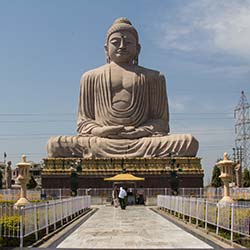
About the Great Buddha Statue, Bodhgaya The Great Buddha Statue in Bodhgaya is a majestic figure that stands tall as a symbol of peace and enlightenment. With a rich history and intricate architecture, this iconic statue attracts visitors from all around the world. History, Architecture, and Design The Great Buddha Statue in Bodhgaya was unveiled in 1989, commemorating the 2,500th anniversary of the Buddha's enlightenment. Standing at a height of 80 feet, the statue is made of sandstone blocks and red granite. The design features intricate carvings and details that represent the Buddha's teachings and journey to enlightenment. Best Time to Visit The best time to visit the Great Buddha Statue in Bodhgaya is during the winter months, from October to March, when the weather is pleasant and suitable for exploring the site. Avoid visiting during the monsoon season, as heavy rains can disrupt your experience. Cultural Significance The Great Buddha Statue holds immense cultural significance as it marks the exact spot where Lord Buddha attained enlightenment. It serves as a reminder of the teachings of peace, compassion, and mindfulness that the Buddha preached, making it a sacred site for Buddhists and spiritual seekers. Pilgrimage Practices Pilgrims from all around the world visit the Great Buddha Statue in Bodhgaya to pay their respects and meditate in the presence of the enlightened one. It is common for visitors to offer prayers, light candles, and perform rituals as a way to connect with the spiritual energy of the site. Dress Code and Etiquette Visitors are expected to dress modestly and respectfully when visiting the Great Buddha Statue in Bodhgaya. It is recommended to wear clothing that covers the shoulders, chest, and knees as a sign of reverence and respect for the sacredness of the site. Activities and Experiences While visiting the Great Buddha Statue, visitors can engage in a variety of activities and experiences such as guided tours, meditation sessions, and cultural performances. The serene surroundings and spiritual ambiance of the site provide a peaceful and introspective experience for all visitors. Art and Religious Symbols The Great Buddha Statue in Bodhgaya is adorned with intricate art and religious symbols that represent the Buddhist faith and teachings. From the lotus flower symbolizing purity to the mudra hand gestures signifying different aspects of the Buddha's journey, every detail of the statue holds deep symbolism and significance. Local Insights Immerse yourself in the local culture and traditions of Bodhgaya by interacting with the friendly locals and exploring the nearby markets and eateries. Gain a deeper understanding of the spiritual significance of the Great Buddha Statue by engaging in conversations with the residents and participating in local customs and rituals.
Explore More
About Tibetan Refugee Market, Bodhgaya History, Architecture and Design The Tibetan Refugee Market in Bodhgaya was established in the 1960s by Tibetan refugees who fled their homeland following the Chinese invasion. The market serves as a hub for the Tibetan community to showcase their traditional crafts and goods. The architecture of the market is inspired by Tibetan design elements, with colorful prayer flags adorning the stalls and intricate wood carvings adding to the charm of the market. Best Time to Visit The best time to visit the Tibetan Refugee Market in Bodhgaya is during the winter months from October to March when the weather is cool and pleasant. This is also the peak tourist season, so you can expect a lively atmosphere at the market during this time. Cultural Significance The Tibetan Refugee Market holds significant cultural importance as it provides a platform for Tibetan refugees to showcase their traditional arts and crafts. It also serves as a reminder of the hardships faced by the Tibetan people and their resilience in preserving their culture and heritage. Pilgrimage Practices Many visitors to Bodhgaya include a visit to the Tibetan Refugee Market as part of their pilgrimage practices. The market offers a unique glimpse into Tibetan culture and traditions, making it a meaningful stop for those on a spiritual journey. Dress Code and Etiquette While there is no strict dress code at the Tibetan Refugee Market, it is important to dress modestly out of respect for the Tibetan culture and traditions. Visitors should also remember to remove their shoes before entering any of the stalls or shops. Activities and Experiences Visitors to the Tibetan Refugee Market can indulge in a variety of activities and experiences, such as shopping for traditional Tibetan handicrafts, sampling authentic Tibetan cuisine, and interacting with the friendly vendors. The market also hosts cultural performances and workshops, providing a deeper insight into Tibetan culture. Art and Religious Symbols The Tibetan Refugee Market is known for its exquisite handicrafts, including intricately carved wooden statues, colorful thangka paintings, and handmade prayer flags. These art pieces often feature religious symbols such as the Buddha, lotus flowers, and the Tibetan Om symbol, adding to the market's spiritual ambiance. Local Insights Visiting the Tibetan Refugee Market in Bodhgaya offers a unique opportunity to connect with the local Tibetan community and gain insights into their culture and way of life. By supporting the vendors and purchasing their handmade goods, visitors can contribute to the economic empowerment of the Tibetan refugees and help preserve their traditional arts and crafts.
Explore More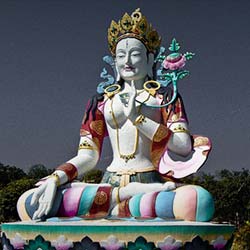
About Mindrolling Monastery Mindrolling Monastery, located in Dehradun, is one of the six major monasteries in Tibet. It was founded in 1676 by Rigzin Terdak Lingpa and holds great historical and cultural significance. The monastery is known for its stunning architecture, intricate design, and religious practices that have been passed down for centuries. History, Architecture, and Design The Mindrolling Monastery has a rich history that dates back to the 17th century when it was established by Rigzin Terdak Lingpa. The monastery's architecture is a blend of traditional Tibetan and modern styles, with colorful murals, ornate decorations, and towering statues of deities. The design of the monastery reflects the intricate details and craftsmanship of Tibetan Buddhist art and architecture. Best Time to Visit The best time to visit Mindrolling Monastery is during the months of September to November when the weather is pleasant and the monastery hosts various cultural events and festivals. Avoid visiting during the monsoon season, as heavy rainfall can make it difficult to explore the monastery. Cultural Significance Mindrolling Monastery is a center for Buddhist teachings, practices, and rituals. It plays a vital role in preserving Tibetan culture and traditions through its religious ceremonies, festivals, and teachings. The monastery is a spiritual hub for Buddhists and tourists seeking peace, enlightenment, and cultural experiences. Pilgrimage Practices Pilgrims visit Mindrolling Monastery to pay homage to the Buddha, seek blessings from the monks, and engage in spiritual practices such as chanting, meditation, and offerings. Pilgrimage practices at the monastery involve circumambulating sacred stupas, prostrating before statues of deities, and participating in religious ceremonies. Dress Code and Etiquette Visitors to Mindrolling Monastery are required to dress modestly and respectfully, covering their shoulders and knees. Remove shoes before entering prayer halls, refrain from taking photographs without permission, and avoid disturbing monks during their prayers and rituals. Follow the monastery's etiquette guidelines to show respect for the sacred space and its inhabitants. Activities and Experiences Visitors to Mindrolling Monastery can partake in various activities and experiences such as attending teachings by Buddhist masters, participating in meditation sessions, exploring the monastery's architecture and art, and shopping for traditional Tibetan handicrafts and souvenirs. Engage in spiritual practices, cultural exchanges, and educational programs offered at the monastery. Art and Religious Symbols The artwork and religious symbols at Mindrolling Monastery are intricately designed to depict Buddhist deities, mandalas, and sacred texts. The murals, thangkas, statues, and sculptures in the monastery reflect the rich tradition of Tibetan Buddhist art and serve as visual aids for meditation, contemplation, and devotion. Each symbol carries profound spiritual meanings and teachings. Local Insights Local insights into Mindrolling Monastery provide visitors with a deeper understanding of its history, culture, and significance. Interact with monks, residents, and guides to learn about Tibetan Buddhism, daily life at the monastery, and local customs. Visit nearby villages, markets, and temples to immerse yourself in the vibrant local community and gain valuable insights into Tibetan culture.
Explore MoreKashmir Delight Tour Package
6 Days/ 5 Night
Srinagar - Pahalgam - Sonamarg - Gulmarg
3 Night - 4 Days Andaman Tour Package
4 Days/ 3 Night
Port Blair - Havelock
5N Ujjain - Maheshwar - Mandu - Indore Tour
6 Days/ 5 Night
Dhar - Indore - Ujjain - Omkareshwara - Khargone
Nainital - Jim Corbett Tour Package From Delhi
5 Days/ 4 Night
Nainital - Corbett
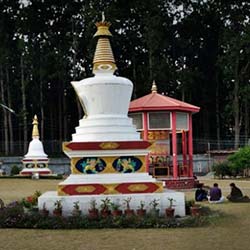
About Tashi Kyil Monastery, Dehradun The Tashi Kyil Monastery, located in Dehradun, is a beautiful and serene Buddhist temple that holds great cultural significance. The monastery is known for its stunning architecture and design, as well as its tranquil surroundings that make it a perfect place for meditation and reflection. History, Architecture, and Design The Tashi Kyil Monastery was founded in the early 20th century by Tibetan refugees who settled in Dehradun. The architecture of the monastery reflects traditional Tibetan Buddhist design, with intricate carvings, colorful murals, and prayer flags adorning the temple. The serene atmosphere and stunning views of the surrounding Himalayan mountains make Tashi Kyil a must-visit destination for spiritual seekers and tourists alike. Best Time to Visit The best time to visit Tashi Kyil Monastery is during the spring and autumn months, when the weather is pleasant and the scenery is at its most picturesque. Avoid visiting during the monsoon season, as heavy rains can make the journey to the monastery difficult and dangerous. Cultural Significance Tashi Kyil Monastery holds great cultural significance for the local Tibetan community, as well as for Buddhists from around the world. The monastery is a sacred place of worship, meditation, and reflection, where visitors can learn about Tibetan Buddhism and immerse themselves in the peaceful atmosphere of the temple. Pilgrimage Practices Visitors to Tashi Kyil Monastery are encouraged to participate in the traditional pilgrimage practices of the Tibetan Buddhists, such as making offerings, spinning prayer wheels, and circumambulating the temple. These practices are believed to bring good luck, prosperity, and spiritual blessings to those who engage in them. Dress Code and Etiquette When visiting Tashi Kyil Monastery, it is important to dress modestly and respectfully, covering your shoulders and knees. Visitors are also expected to remove their shoes before entering the temple and to maintain a quiet and reverent demeanor while inside. Photography is typically not allowed inside the monastery, so be sure to respect the rules and regulations of the temple. Activities and Experiences While at Tashi Kyil Monastery, visitors can participate in a variety of activities and experiences, such as attending meditation sessions, receiving blessings from the resident monks, and exploring the beautiful gardens and grounds of the temple. The monastery also hosts cultural events and festivals throughout the year, providing visitors with a unique opportunity to immerse themselves in Tibetan Buddhist culture. Art and Religious Symbols The walls and ceilings of Tashi Kyil Monastery are adorned with intricate murals and paintings depicting Buddhist deities, symbols, and teachings. These sacred artworks serve as a visual representation of the core beliefs and principles of Tibetan Buddhism, inviting visitors to contemplate the deeper meaning of life and enlightenment. Local Insights Local residents and monks at Tashi Kyil Monastery are more than happy to share their insights and knowledge about Tibetan Buddhism, the history of the monastery, and the cultural traditions of the Tibetan community. Visitors are encouraged to engage with the locals, ask questions, and learn more about the rich heritage and spirituality of this sacred place.
Explore More
About Namgyal Monastery History, Architecture, and Design Namgyal Monastery is the personal monastery of the 14th Dalai Lama and is located in the town of Dharamshala in Himachal Pradesh, India. Founded in 1575 by the 3rd Dalai Lama, Sonam Gyatso, the monastery has a rich history and serves as one of the most important Tibetan monasteries outside of Tibet. The architecture of Namgyal Monastery is a blend of Tibetan and Indian styles, with colorful prayer flags fluttering in the wind and intricately carved wooden doors. The design of the monastery reflects the spiritual beliefs and practices of Tibetan Buddhism. Best Time to Visit The best time to visit Namgyal Monastery in Dharamshala is during the spring and autumn months, from March to May and September to November. The weather during these months is pleasant, with clear skies and comfortable temperatures, making it ideal for exploring the monastery and taking part in any cultural events or religious ceremonies that may be taking place. Cultural Significance Namgyal Monastery holds great cultural significance for Tibetan Buddhists and serves as a center for religious teachings, meditation practices, and rituals. The monastery is a focal point for the preservation and promotion of Tibetan culture and traditions in exile, as well as a place of refuge for those seeking spiritual guidance and enlightenment. Pilgrimage Practices Pilgrims from all over the world travel to Namgyal Monastery in Dharamshala to pay their respects to the Dalai Lama and to participate in religious ceremonies and teachings. Pilgrimage practices at the monastery may include offering prayers, lighting butter lamps, and receiving blessings from monks. Visitors are encouraged to observe proper etiquette and respect the traditions of the monastery during their pilgrimage. Dress Code and Etiquette Visitors to Namgyal Monastery are expected to dress modestly and respectfully, covering their shoulders and knees while on monastery grounds. It is also important to remove shoes before entering any prayer halls or temples and to refrain from taking photographs without permission. Visitors should also be mindful of their behavior and show respect for the monks and other practitioners at the monastery. Activities and Experiences Visitors to Namgyal Monastery can participate in a variety of activities and experiences, including attending meditation sessions, listening to teachings from resident monks, and taking part in traditional Tibetan rituals and ceremonies. The monastery also offers classes in Tibetan language, art, and philosophy for those interested in learning more about Tibetan culture and Buddhism. Art and Religious Symbols The walls of Namgyal Monastery are adorned with colorful thangka paintings, intricate wooden carvings, and sacred religious symbols such as the wheel of dharma and the lotus flower. These art forms serve as visual representations of Buddhist teachings and help to create a peaceful and meditative atmosphere within the monastery. Local Insights Local residents of Dharamshala and the surrounding area hold Namgyal Monastery in high esteem as a place of spiritual refuge and community gathering. The monastery plays an important role in the daily lives of locals, who often visit to offer prayers, receive blessings, and seek guidance from the resident monks. Visitors to the area can gain valuable insights into Tibetan culture and traditions by interacting with local residents and participating in events at the monastery.
Explore More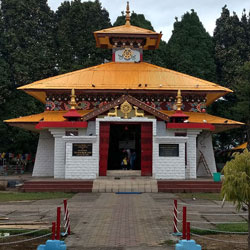
About Buddha Temple, Itanagar History The Buddha Temple in Itanagar, also known as the Namdapha Vihar, was built in 1965 by the 14th Dalai Lama. It is a significant place of worship for Buddhists in the region and serves as a reminder of the rich cultural heritage of Arunachal Pradesh. Architecture and Design The temple features traditional Tibetan architectural styles with its colorful pagoda-style rooftop and intricate carvings. The interior is adorned with beautiful murals and statues of Buddha and other deities, creating a serene and peaceful atmosphere for visitors. Best Time to Visit The best time to visit the Buddha Temple in Itanagar is during the winter months from October to March when the weather is cool and pleasant. Avoid visiting during the monsoon season as heavy rains can disrupt travel plans. Cultural Significance The Buddha Temple is not only a place of worship but also a cultural hub for the local Buddhist community. It serves as a center for religious ceremonies, teachings, and festivals, showcasing the rich traditions and beliefs of the region. Pilgrimage Practices Visitors to the Buddha Temple can participate in traditional Buddhist practices such as meditation, chanting, and offering prayers. Pilgrims often walk clockwise around the temple while reciting mantras and making offerings to the Buddha. Dress Code and Etiquette Visitors to the Buddha Temple are advised to dress modestly and respectfully, covering shoulders and knees. It is customary to remove shoes before entering the temple and to avoid taking photos or videos inside the sacred space out of respect for the religious practices. Activities and Experiences Aside from attending religious ceremonies and prayers, visitors to the Buddha Temple can also explore the surrounding gardens and enjoy panoramic views of the city from the temple's vantage point. Local vendors sell traditional handicrafts and souvenirs near the temple grounds. Art and Religious Symbols The Buddha Temple is adorned with intricate artworks and religious symbols that reflect the teachings and beliefs of Buddhism. Visitors can admire statues of Buddha in various poses, colorful prayer flags, and elaborate mandalas that represent spiritual enlightenment and harmony. Local Insights For a deeper understanding of the cultural significance of the Buddha Temple, visitors can engage with local monks and residents who are happy to share their knowledge and experiences. Learning about the history and rituals of the temple from locals adds a unique perspective to the visit.
Explore More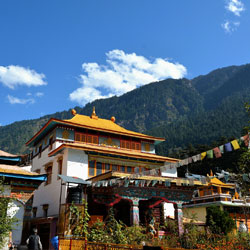
About Tibetan Monasteries Tibetan monasteries are spiritual centers preserving Buddhist traditions, culture, and teachings. Known for their serene ambiance, vibrant murals, and intricate architecture, they serve as meditation hubs for monks and visitors. Famous monasteries include Namgyal, Tawang, and Hemis, offering insights into Tibetan Buddhism, rituals, and monastic life. Tibetan Monasteries in Manali are not only religious centers but also serve as cultural hubs for the Tibetan community in the area. These monasteries are known for their stunning architecture, vibrant prayer flags, and peaceful surroundings. Architectural Facts The Tibetan Monasteries in Manali are characterized by intricate wood carvings, colorful murals, and traditional Tibetan architecture. The buildings typically feature ornate pagodas, prayer wheels, and Buddhist symbols, creating a serene atmosphere for visitors to explore and reflect. History The Tibetan Monasteries in Manali were established to preserve and promote Tibetan culture and Buddhism in exile. These monasteries serve as important religious and educational institutions for the Tibetan community, offering teachings, rituals, and ceremonies to local and visiting practitioners. Location The Tibetan Monasteries are located in various parts of Manali, with the most famous ones including the Gadhan Thekchhokling Gompa, Himalayan Nyingmapa Gompa, and the famous monastery in the nearby town of Rewalsar. Visiting Hours The monasteries are usually open to visitors from early morning till evening. It is recommended to check the specific visiting hours of each monastery before planning your visit. Gurudwara Services and Events The Tibetan Monasteries in Manali often host special events, ceremonies, and festivals throughout the year. Visitors can experience traditional Tibetan rituals, prayers, and cultural performances during these events. The monasteries may also offer guided tours and meditation sessions for interested visitors. Accessibility and Directions Visitors can reach the Tibetan Monasteries in Manali by car or public transport. The monasteries are easily accessible from the main town and are well signposted. Parking facilities are available near most monasteries, and some may offer wheelchair accessibility for those with mobility challenges. Visitor’s Information There is usually no entry fee to visit the Tibetan Monasteries in Manali, but donations are welcome to support the upkeep of the monasteries. Visitors are advised to dress modestly and remove shoes before entering the prayer halls. Guides may be available to provide information about the history and traditions of the monasteries. Nearby attractions to visit around the monasteries include scenic viewpoints, hiking trails, and local markets. Best Time to Visit The best time to visit the Tibetan Monasteries in Manali is during the spring and autumn months when the weather is pleasant and many festivals and events take place. The monasteries are also popular destinations for weekend getaways and spiritual retreats.
Explore More
About The Manali Gompa History The Manali Gompa, also known as the Gadhan Thekchhokling Gompa, is a Buddhist monastery located in the town of Manali in the Indian state of Himachal Pradesh. The monastery was built in the 1960s by Tibetan refugees who settled in the region. It is a peaceful sanctuary that serves as a place of worship, meditation, and learning for the local Buddhist community and visitors alike. Architecture and Design The Manali Gompa features traditional Tibetan architecture with a pagoda-style structure adorned with intricate paintings, colorful prayer flags, and prayer wheels. The monastery is surrounded by lush greenery and offers panoramic views of the surrounding mountains, creating a serene and tranquil atmosphere for visitors to explore and experience. Best Time to Visit The best time to visit the Manali Gompa is during the months of May to June and September to October when the weather is pleasant and the surrounding landscape is lush and vibrant. Avoid visiting during the winter months as the region experiences heavy snowfall, making travel difficult. Cultural Significance The Manali Gompa is an important cultural and religious site for the Tibetan Buddhist community in the region. It serves as a center for religious ceremonies, teachings, and cultural events, preserving the rich heritage and traditions of Tibetan Buddhism for future generations to experience and learn from. Pilgrimage Practices Visitors to the Manali Gompa can participate in traditional Buddhist practices such as meditation, chanting, and offering prayers. Pilgrims often circumambulate the monastery while spinning prayer wheels and offering butter lamps as a form of devotion and spiritual practice. Dress Code and Etiquette Visitors to the Manali Gompa are expected to dress modestly and respectfully, covering their shoulders and legs out of respect for the sacredness of the site. It is also important to maintain a quiet and peaceful demeanor while inside the monastery, refraining from loud conversations or disruptive behavior. Activities and Experiences Visitors to the Manali Gompa can participate in a variety of activities and experiences, including attending religious ceremonies, receiving blessings from the resident monks, exploring the monastery's grounds and surrounding gardens, and learning about the history and teachings of Tibetan Buddhism through guided tours and cultural programs. Art and Religious Symbols The Manali Gompa is adorned with stunning artwork and religious symbols that tell the stories and teachings of Tibetan Buddhism. Visitors can admire the intricate murals, statues, and thangka paintings that decorate the walls and interiors of the monastery, each carrying deep spiritual and cultural significance. Local Insights Local residents and monks at the Manali Gompa are happy to share their knowledge and insights into Tibetan Buddhism and the history of the monastery with visitors. By engaging with the community and participating in cultural events and ceremonies, visitors can gain a deeper understanding and appreciation for the traditions and practices of Tibetan Buddhism.
Explore More
About Anupu, Nagarjunakonda Anupu, near Nagarjunakonda in Andhra Pradesh, is an ancient Buddhist site reconstructed to preserve ruins from the submerged Nagarjunakonda valley. It features a majestic amphitheater, viharas, stupas, and intricate carvings reflecting Buddhist architecture. A significant archaeological and historical site, it offers insights into India's rich Buddhist heritage. History Anupu, also known as Nagarjunakonda, is a historical site located in the Indian state of Andhra Pradesh. It was once a thriving Buddhist settlement during the 2nd and 3rd centuries CE. The site is famous for its ancient ruins, including stupas, monasteries, and rock-cut caves, which provide insight into the region's rich cultural and architectural heritage. Architecture and Design The architecture of Anupu reflects the Buddhist influence on the region, with intricately carved sculptures and stone structures. The design of the stupas and monasteries showcases the skilled craftsmanship of the artisans who built them. Visitors can marvel at the intricate details and historical significance of the structures as they explore the site. Best Time to Visit Cultural Significance Anupu holds immense cultural significance as a former Buddhist settlement and a historical site. It is a testament to the region's rich history and religious heritage. The site offers visitors a chance to experience the ancient ways of life and appreciate the architectural and artistic achievements of the past. Pilgrimage Practices Many visitors to Anupu come to pay their respects to the Buddhist monks who once inhabited the site. Pilgrims often engage in prayers and meditation at the various shrines and stupas scattered throughout the area. The tranquil surroundings provide a perfect setting for spiritual reflection and contemplation. Dress Code and Etiquette Visitors to Anupu are advised to dress modestly and respectfully, in keeping with the religious and cultural significance of the site. It is recommended to cover your shoulders and knees and remove your shoes before entering any of the sacred spaces. Visitors are also encouraged to maintain a peaceful and contemplative demeanor while exploring the site. Activities and Experiences Art and Religious Symbols The art and religious symbols found at Anupu are a testament to the Buddhist influence on the region. Visitors can admire the intricate carvings, statues, and paintings that adorn the various structures at the site. These symbols serve as a reminder of the spiritual beliefs and practices of the ancient inhabitants of Nagarjunakonda. Local Insights Local guides and experts at Anupu can provide visitors with valuable insights into the history and significance of the site. They can offer a deeper understanding of the architecture, art, and religious practices of the Buddhist monks who once lived there. Engaging with locals can enhance your experience and appreciation of Anupu's cultural heritage.
Explore More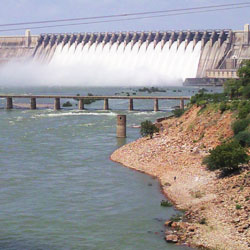
Nagarjuna Sagar, an erstwhile prominent Buddhist center, is the most attractive tourist spot in Andhra Pradesh. Named after the Buddhist monk, Acharya Nagarjuna, it is today the major hydel power station in Andhra Pradesh. It is the tallest masonry dam in the World, constructed on the river Krishna. Nagarjuna Sagar dam is located on the border of Guntur - Nalgonda districts. The dam was completed in 1966 and it is 124 metres high and 1 km long. It is built across the river Krishna and has one of the largest networks of canal systems irrigating over 2,000,000 acres of land in Guntur, Prakasam, Nalgonda, Khammam and Krishna districts. 4 kms away from the dam, is the viewpoint, where a panoramic view of the amazing landscape, is simply a feast to the eyes. One can find the image of Nagarjuna, on a pylon not too far from the dam.
Explore More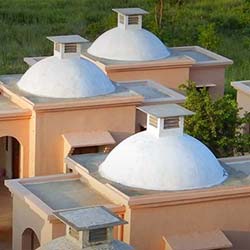
About Dhamma Nagajjuna, Nagarjunakonda History Dhamma Nagajjuna, also known as Nagarjunakonda, is a historical and religious site located in India. It is believed to have been a center for Buddhist learning and practice during the ancient times. The site has a rich history dating back to the 3rd century BC when it was founded by the Mauryan Empire. Over the centuries, it has been a significant pilgrimage site for Buddhists and a place of cultural significance. Architecture and Design The architecture of Dhamma Nagajjuna reflects the ancient Buddhist style with intricately carved pillars, stupas, and viharas. The design of the site is a blend of Indian and Buddhist architectural elements, showcasing the craftsmanship of the artisans of that time. Visitors can marvel at the ancient ruins and appreciate the beauty and symmetry of the structures. Best Time to Visit The best time to visit Dhamma Nagajjuna, Nagarjunakonda, is during the winter months from November to February when the weather is pleasant and cool. The monsoon season from June to September should be avoided as the site can be slippery and prone to landslides during this time. Cultural Significance Dhamma Nagajjuna holds immense cultural significance as a place of Buddhist pilgrimage and learning. It is believed to be the birthplace of the renowned Buddhist scholar Nagarjuna, whose teachings and philosophy continue to influence Buddhists around the world. The site also showcases the rich cultural heritage of ancient India and the architectural prowess of that era. Pilgrimage Practices Pilgrims visiting Dhamma Nagajjuna often engage in rituals such as offering prayers, chanting mantras, and circumambulating the stupas. Many also participate in meditation sessions and attend lectures on Buddhist teachings. Pilgrimage practices at the site are aimed at spiritual growth, enlightenment, and seeking blessings from the Buddha. Dress Code and Etiquette Visitors to Dhamma Nagajjuna are advised to dress modestly and respectfully, covering their shoulders and knees. Shoes are generally removed before entering the sacred spaces, and photography may be restricted in certain areas. It is important to maintain silence and show reverence towards the religious artifacts and structures at the site. Activities and Experiences Visitors to Dhamma Nagajjuna can engage in a variety of activities such as exploring the ancient ruins, attending meditation sessions, and participating in cultural performances. Guided tours are available for those interested in learning more about the history and significance of the site. Visitors can also enjoy boat rides on the nearby lake and soak in the tranquil atmosphere of the surroundings. Art and Religious Symbols The art and religious symbols at Dhamma Nagajjuna reflect the intricate craftsmanship and deep spiritual meanings of Buddhist culture. Visitors can admire the carvings of Buddha statues, lotus flowers, and other symbols of enlightenment. The artwork at the site serves as a visual representation of Buddhist teachings and beliefs, providing a sense of peace and tranquility to visitors. Local Insights Local guides and residents at Dhamma Nagajjuna offer valuable insights into the history, culture, and significance of the site. They share stories and legends passed down through generations, providing a unique perspective on the spiritual and historical importance of the place. Visitors can interact with the locals, learn about their traditions, and gain a deeper understanding of the Buddhist heritage of the region.
Explore More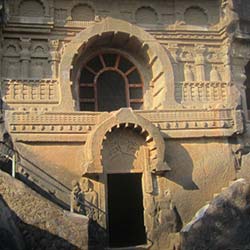
About 8 Kms South of Nasik, is a group of 24 Hinayana Buddhist Caves dating from around the 1st century BC to the 2nd AD. The most important in this group are number 18 and 20. Except caves no. 18, the rest of the caves are Viharas or Monasteries. This group of caves is one of the most important and intriguing in western India. The oldest historical place in Nashik is Pandav caves which are also known as Trirashmi Leni. The famous Dadasaheb Phalke Smarak and Buddhasmarak are soon to be opened for public, which are known for their creativity and only of their kind. Cave 3 is a large vihara with some interesting sculptures. Cave 10 is also a vihara and almost identical in design to cave 3, although it is much older and finer in its detail. It is thought to be nearly as old as the Karla Cave near Lonavala. Cave 18 is a chaitya believed to date from the same time as the Karla Cave and is well sculptured. Its elaborate facade is particularly noteworthy. The cave houses the idols of Buddha, Jain Teerthankara Vrishabhdeo, the icons of Bodhisatva, Veer Manibhadraji and Ambikadevi. The interiors of the caves were popular meeting places for the disciples, where sermons were conducted. There are attractive water tanks very skillfully chiselled into the rock. The 2000-yr-old Pandavleni caves, built by the Jain kings, are located on a tableland atop the Trivashmi Hill, close to the Mumbai Road.
Explore More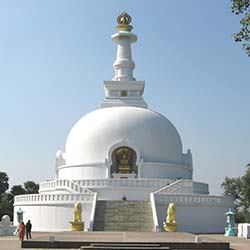
About Vishwa Shanti Stupa, Vaishali Vishwa Shanti Stupa, located in Vaishali, Bihar, is a symbol of peace and harmony. This majestic monument stands tall as a beacon of tranquility in the bustling town. The stupa is a unique blend of history, architecture, and cultural significance, making it a must-visit destination for tourists and pilgrims alike. History, Architecture, and Design Constructed in 1996 by the Nipponzan Myohoji sect of Japan, the Vishwa Shanti Stupa is a stunning example of Buddhist architecture. The stupa's design reflects the principles of peace and non-violence, with intricate carvings and sculptures adorning its walls. The stupa's construction is a testament to the strong cultural ties between India and Japan, symbolizing the enduring friendship between the two nations. Best Time to Visit The best time to visit Vishwa Shanti Stupa is during the winter months, from October to March. The weather is pleasant and ideal for exploring the stupa and its surroundings. Avoid visiting during the monsoon season, as heavy rains may disrupt your trip. Cultural Significance Vishwa Shanti Stupa holds immense cultural significance for Buddhists and people of all faiths. It serves as a place of meditation and reflection, where visitors can experience inner peace and spiritual enlightenment. The stupa's serene ambiance and beautiful surroundings make it a popular pilgrimage site for those seeking solace and tranquility. Pilgrimage Practices Visitors to Vishwa Shanti Stupa are encouraged to participate in meditation sessions and prayer rituals conducted by the resident monks. Pilgrims can also offer prayers and light candles at the stupa, seeking blessings and guidance for their spiritual journey. It is essential to maintain silence and reverence while visiting the stupa, to respect its sacredness. Dress Code and Etiquette While visiting Vishwa Shanti Stupa, it is advisable to dress modestly and respectfully. Both men and women should wear clothing that covers their shoulders and knees, out of respect for the religious significance of the site. Visitors are also expected to remove their shoes before entering the stupa premises, as a sign of reverence and humility. Activities and Experiences At Vishwa Shanti Stupa, visitors can engage in a variety of activities that promote peace and harmony. From attending meditation workshops to participating in cultural events, there are ample opportunities to immerse yourself in the spiritual ambiance of the stupa. Don't miss the chance to witness the evening prayer ceremony, where the stupa is illuminated with glowing lights and chants fill the air. Art and Religious Symbols The Vishwa Shanti Stupa is adorned with intricate artworks and religious symbols that convey deep spiritual meanings. From Buddha's teachings to symbols of peace and enlightenment, the stupa's architecture is a visual representation of Buddhist philosophy. Each carving and sculpture tells a story of compassion, wisdom, and inner harmony, inspiring visitors to seek a higher state of consciousness. Local Insights Exploring Vishwa Shanti Stupa offers a unique opportunity to learn about the local culture and traditions of Vaishali. Interact with the resident monks and locals to gain insights into the history and significance of the stupa. Visit nearby temples and markets to experience the vibrant essence of Vaishali, and savor traditional dishes at local eateries for a taste of authentic Bihar cuisine.
Explore More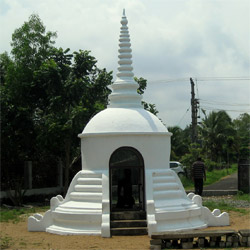
About Karumadikuttan, Alleppey History Karumadikuttan in Alleppey, Kerala, is a historical site with a black granite statue believed to be of Lord Buddha. This ancient statue dates back to the 9th or 10th century and is a significant archaeological find in the region. Architecture and Design The striking black granite statue of Karumadikuttan is beautifully crafted and stands as a testament to the skilled craftsmanship of the artisans of that era. The serene and meditative expression on Lord Buddha's face adds to the spiritual appeal of the statue. Best Time to Visit The best time to visit Karumadikuttan in Alleppey is during the winter months of October to March when the weather is pleasant and conducive for sightseeing and exploring the historical site. Cultural Significance Karumadikuttan holds immense cultural significance for the local people in Alleppey as it is believed to be a sacred place where devotees come to pay their respects and seek blessings from Lord Buddha. Pilgrimage Practices Visitors to Karumadikuttan often engage in pilgrimage practices such as offering flowers, lighting incense, and chanting prayers as a way to show their devotion and reverence towards the ancient statue of Lord Buddha. Dress Code and Etiquette Visitors are advised to dress modestly and respectfully when visiting Karumadikuttan out of respect for the religious and cultural significance of the site. It is important to maintain decorum and follow the rules and guidelines set by the authorities. Activities and Experiences Some of the activities and experiences that visitors can enjoy at Karumadikuttan include exploring the surrounding area, taking in the tranquil ambiance, and participating in the spiritual practices offered at the site. Art and Religious Symbols The artistry of the black granite statue of Lord Buddha at Karumadikuttan is a religious symbol that represents peace, enlightenment, and spiritual awakening. The intricate details and serene expression on the face of the statue reflect the essence of Buddhism. Local Insights Local insights reveal that Karumadikuttan is not just a historical site but also a place of reverence and spiritual significance for the people of Alleppey. The locals hold the ancient statue of Lord Buddha in high regard and consider it a symbol of peace and harmony.
Explore More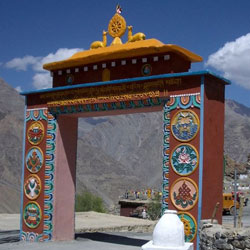
About Lhalung Monastery, Lahaul & Spiti History: Lhalung Monastery, also known as the Golden Temple, is one of the oldest monasteries in Lahaul & Spiti district of Himachal Pradesh, India. It was founded in the 10th century by Rinchen Zangpo, a famous Tibetan translator who was responsible for building several monasteries in the region. Architecture and Design: The monastery is built in traditional Tibetan architectural style, with whitewashed walls and colorful prayer flags adorning the exterior. The main prayer hall houses a statue of Lord Buddha and intricate wall paintings depicting Buddhist scriptures and deities. Best Time to Visit Cultural Significance: Lhalung Monastery holds great cultural significance for the local community, as it serves as a spiritual and educational center for Buddhist monks and nuns. It also plays an important role in preserving the rich cultural heritage of the region. Pilgrimage Practices: Many pilgrims visit Lhalung Monastery throughout the year to pay their respects to the Buddha and seek blessings from the resident monks. Pilgrims often participate in prayer ceremonies and rituals during their visit. Dress Code and Etiquette: Visitors to Lhalung Monastery are expected to dress modestly and respectfully, covering their shoulders and knees. It is important to remove shoes before entering the prayer halls and to maintain a quiet and peaceful demeanor while on the monastery grounds. Activities and Experiences Art and Religious Symbols: The monastery is adorned with colorful murals, thangka paintings, and intricately carved pillars that showcase the artistic and religious traditions of Tibetan Buddhism. Visitors can immerse themselves in the beauty and symbolism of these sacred artworks. Local Insights: Visitors to Lhalung Monastery have the opportunity to interact with local monks and nuns, gaining insights into their daily lives, spiritual practices, and cultural traditions. This firsthand experience allows for a deeper appreciation of the monastery and its significance in the community. Overall, Lhalung Monastery offers a unique and enriching cultural experience for visitors seeking to explore the spiritual and artistic heritage of Lahaul & Spiti.
Explore MoreAmazing Andaman 5 Night - 6 Days Tour
6 Days/ 5 Night
Port Blair - Havelock - Neil Island
Summer Goa Escape 2N - 3D Tour
3 Days/ 2 Night
Goa City - North Goa - South Goa
Mesmerizing Andaman 6 Night - 7 Days Tour
7 Days/ 6 Night
Port Blair - Havelock - Neil Island - Baratang Island
10 Night 11 Days Char Dham Yatra 2026
11 Days/ 10 Night
Kedarnath - Badrinath - Yamunotri - Gangotri
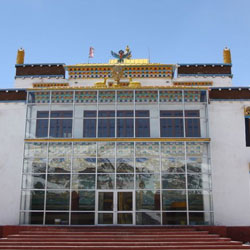
About Kungri Monastery History Kungri Monastery, located in the picturesque region of Lahaul & Spiti in Himachal Pradesh, has a rich history dating back several centuries. It was founded by Lama Norbu Dorje in the 14th century and has since been a spiritual hub for the local community. Architecture and Design The monastery is known for its traditional Tibetan architecture, with intricate carvings, vibrant murals, and prayer wheels adorning its walls. The main prayer hall is adorned with colorful thangkas and statues of Buddhist deities, creating a serene and sacred atmosphere. Best Time to Visit Cultural Significance Kungri Monastery holds immense cultural significance for the people of Lahaul & Spiti, serving as a center for religious ceremonies, teachings, and festivals. It is a place where locals come to seek blessings, meditate, and connect with their spiritual roots. Pilgrimage Practices Pilgrims visit Kungri Monastery throughout the year, but the most popular time is during the annual festival of Tsechu, where monks perform sacred rituals, dances, and prayers to commemorate the teachings of Buddha. Dress Code and Etiquette Visitors to Kungri Monastery are expected to dress modestly and respectfully, covering their shoulders and knees. It is important to maintain a quiet and reverent demeanor while inside the monastery, as it is a place of worship and meditation. Activities and Experiences Art and Religious Symbols The monastery is adorned with exquisite artwork, including intricate mandalas, thangkas, and statues that depict the rich religious symbolism of Tibetan Buddhism. Visitors can immerse themselves in the beauty and symbolism of these sacred artworks. Local Insights Exploring Kungri Monastery offers a unique opportunity to gain insight into the local culture and way of life in Lahaul & Spiti. Visitors can interact with monks, participate in prayers and rituals, and learn about the traditions and beliefs that have been passed down through generations.
Explore More
About Tabo Caves, Lahaul & Spiti The Tabo Caves in Lahaul & Spiti are a fascinating archaeological site, known for their historical significance and unique architecture and design. These caves have been used by monks and spiritual seekers for meditation and retreat for centuries. History The Tabo Caves have a rich history dating back to over a thousand years. They were originally used as a place of meditation and worship by Buddhist monks. The caves also served as a refuge for those seeking spiritual enlightenment. Architecture and Design The caves are carved into the cliffs of the Himalayas and feature intricate designs and murals depicting Buddhist teachings and symbols. The architecture reflects the ancient Buddhist traditions and the spiritual significance of the site. Best Time to Visit The best time to visit the Tabo Caves in Lahaul & Spiti is during the summer months, from May to September. This is when the weather is pleasant, and the caves are accessible for exploration. The winter months can be harsh and snowy, making it difficult to visit the site. Cultural Significance The Tabo Caves hold great cultural significance for the people of Lahaul & Spiti and Buddhists around the world. They are considered sacred and are a place of pilgrimage for many believers. The caves are also a reflection of the region's rich Buddhist heritage. Pilgrimage Practices Visitors to the Tabo Caves are encouraged to engage in respectful and mindful practices during their visit. Pilgrims often participate in meditation and prayer at the site, seeking spiritual growth and enlightenment. It is important to follow local customs and traditions while visiting the caves. Dress Code and Etiquette It is important to dress modestly and respectfully when visiting the Tabo Caves. Visitors should cover their shoulders and knees and avoid wearing revealing clothing. It is also important to maintain a quiet and reverent demeanor while exploring the caves, out of respect for the spiritual significance of the site. Activities and Experiences Visitors to the Tabo Caves can partake in a variety of activities and experiences, including guided tours, meditation sessions, and cultural performances. Exploring the intricate murals and designs within the caves can offer a profound spiritual experience. Visitors can also enjoy the scenic beauty of the surrounding Himalayan mountains. Art and Religious Symbols The Tabo Caves are adorned with beautiful murals and art depicting Buddhist teachings and religious symbols. The intricate designs and vibrant colors convey the spiritual significance of the site and offer visitors a glimpse into the ancient traditions of Buddhism. These artistic representations serve as a visual reminder of the teachings and philosophies of the faith. Local Insights Local residents of Lahaul & Spiti can provide valuable insights into the history and significance of the Tabo Caves. They can offer guidance on the best times to visit, local customs and traditions, and the spiritual practices associated with the site. Engaging with the local community can enhance the overall experience of exploring the caves and deepen one's understanding of the region's cultural heritage.
Explore More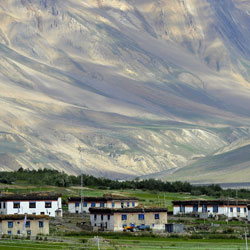
About Losar, Lahaul & Spiti History, Architecture, and Design Losar, Lahaul & Spiti is a region located in the Indian state of Himachal Pradesh. It is known for its rich history and unique architecture influenced by Tibetan and Indian cultures. The traditional houses in the area are built using stone and wood, with colorful prayer flags adorning the rooftops. The monasteries in Losar, Lahaul & Spiti are architectural marvels, showcasing intricate designs and vibrant murals depicting Buddhist teachings. Best Time to Visit The best time to visit Losar, Lahaul & Spiti is during the summer months, from June to September. The weather during this time is pleasant, with clear skies and mild temperatures, making it ideal for exploring the region's stunning landscapes and cultural sites. Cultural Significance Losar, Lahaul & Spiti is steeped in cultural significance, with Buddhism being a major influence on the local traditions and way of life. The region is home to several ancient monasteries, where rituals and ceremonies are performed to honor the teachings of Buddha. Festivals such as Losar, the Tibetan New Year, are celebrated with great fervor, showcasing the vibrant cultural heritage of the region. Pilgrimage Practices Pilgrimage practices are an integral part of the spiritual life in Losar, Lahaul & Spiti. Many devotees embark on journeys to sacred sites and monasteries to seek blessings and enlightenment. Pilgrims often perform rituals such as circumambulating stupas and offering prayers, as a way to deepen their connection to the divine. Dress Code and Etiquette When visiting Losar, Lahaul & Spiti, it is important to dress modestly and respectfully, especially when entering monasteries and religious sites. Visitors are advised to wear conservative clothing that covers their shoulders and knees, as a sign of respect for the local customs and traditions. It is also customary to remove shoes before entering temples and monasteries. Activities and Experiences Visitors to Losar, Lahaul & Spiti can enjoy a variety of activities and experiences, ranging from trekking in the pristine mountains to attending traditional Buddhist ceremonies. Other popular activities include visiting the ancient monasteries, exploring local markets, and participating in cultural festivals. The region also offers opportunities for meditation and spiritual retreats, allowing visitors to connect with their inner selves in a tranquil environment. Art and Religious Symbols Art and religious symbols play a significant role in the culture of Losar, Lahaul & Spiti. The region is known for its intricate thangka paintings, vibrant murals, and intricately carved statues depicting Buddhist deities and symbols. These artistic expressions serve as a form of meditation and devotion, conveying spiritual teachings and inspiring a sense of awe and reverence among the faithful. Local Insights Local insights into the customs and traditions of Losar, Lahaul & Spiti can offer visitors a deeper understanding of the rich cultural heritage of the region. Through interactions with the local community, visitors can learn about the daily life, beliefs, and practices of the people living in this remote corner of the Himalayas. Engaging with locals in conversations, sharing meals, and participating in traditional activities can provide a unique and authentic cultural experience.
Explore More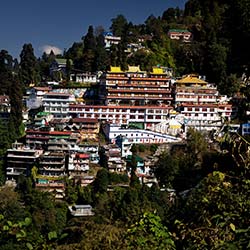
About Dali Monastery The Dali Monastery, located in Darjeeling, is a prominent Tibetan Buddhist monastery known for its stunning architecture and serene surroundings. It was built in the early 1970s and serves as a place of worship, learning, and meditation for the local Buddhist community. The monastery is dedicated to the Dali Lama, the spiritual leader of Tibetan Buddhism, and is a must-visit destination for those seeking spiritual enlightenment and inner peace. History, Architecture, and Design The Dali Monastery is a beautiful example of traditional Tibetan architecture, with its colorful prayer flags, intricate wood carvings, and golden roof. The monastery's design reflects the rich cultural heritage of Tibetan Buddhism, with its ornate temples, prayer halls, and meditation rooms. Visitors can admire the stunning frescoes, statues, and thangka paintings that adorn the monastery's walls, depicting various Buddhist deities and symbols. The monastery's peaceful atmosphere and breathtaking views of the surrounding mountains make it a truly special place to visit. Best Time to Visit The best time to visit the Dali Monastery is during the spring and autumn months, when the weather is mild and the skies are clear. This is the perfect time to explore the monastery's grounds, participate in meditation sessions, and witness traditional Buddhist ceremonies. Additionally, the annual Dali Lama's birthday celebration, held in July, is a major event at the monastery and a great opportunity to experience the local culture and traditions. Cultural Significance The Dali Monastery holds great cultural significance for the Tibetan Buddhist community in Darjeeling. It serves as a vital center for religious teachings, rituals, and ceremonies, and plays a key role in preserving and promoting Tibetan Buddhist culture and traditions. The monastery's monks are highly respected for their knowledge, wisdom, and compassion, and are revered by the local community for their dedication to spiritual practice and service to others. Pilgrimage Practices Visitors to the Dali Monastery can participate in various pilgrimage practices, such as circumambulating the monastery's prayer wheels, offering prayers and offerings at the shrines, and receiving blessings from the resident monks. Pilgrims are encouraged to cultivate mindfulness, compassion, and gratitude during their visit, and to reflect on the teachings of the Buddha as they explore the monastery's sacred spaces. Dress Code and Etiquette Visitors to the Dali Monastery are expected to dress modestly and respectfully, covering their shoulders and knees and removing their shoes before entering the temple grounds. It is important to observe silence and mindfulness while on the monastery's premises, and to show reverence and humility towards the resident monks and other worshippers. Photography is allowed in certain areas of the monastery, but it is important to ask for permission before taking photos of the monks or sacred objects. Activities and Experiences Visitors to the Dali Monastery can participate in a variety of activities and experiences, such as attending meditation sessions, participating in chanting ceremonies, and receiving teachings from the resident monks. The monastery also offers classes in Tibetan Buddhism, meditation, and traditional arts and crafts, providing visitors with a unique opportunity to deepen their spiritual practice and expand their cultural knowledge. Art and Religious Symbols The Dali Monastery is adorned with a wealth of beautiful art and religious symbols, including thangka paintings, mandalas, and statues of Buddha and various deities. These artistic creations serve as powerful teaching tools, conveying the wisdom and compassion of the Buddha and inspiring devotion and contemplation in the hearts of the faithful. Visitors can learn about the symbolism and significance of these sacred artworks by participating in guided tours and workshops offered at the monastery. Local Insights Exploring the Dali Monastery with a local guide can provide valuable insights into the history, culture, and spiritual practices of the Tibetan Buddhist community in Darjeeling. Local guides can offer a deeper understanding of the monastery's architecture, art, and rituals, as well as share personal anecdotes and stories about their own experiences at the monastery. Engaging with the local community through interactions with monks, pilgrims, and artisans can also enrich visitors' understanding of Tibetan Buddhist culture and strengthen their connection to the spiritual essence of the Dali Monastery.
Explore More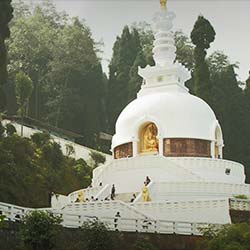
About Peace Pagoda, Darjeeling History The Peace Pagoda in Darjeeling was built under the guidance of Nichidatsu Fujii, a Japanese Buddhist monk, as a symbol of peace and harmony. It was inaugurated in 1992 by the Dalai Lama. The pagoda serves as a testament to the enduring friendship between India and Japan. Architecture and Design The Peace Pagoda follows traditional Japanese architectural style with its white dome and golden spire. The structure is adorned with intricate carvings and statues of Buddha, depicting various stages of his life. The pagoda stands tall amidst lush greenery, offering a serene and tranquil atmosphere to visitors. Best Time to Visit The best time to visit the Peace Pagoda in Darjeeling is during the months of March to May and September to November when the weather is pleasant and favorable for sightseeing. Avoid visiting during the monsoon season as heavy rainfall may disrupt your plans. Cultural Significance The Peace Pagoda is a symbol of peace, unity, and universal brotherhood. It serves as a place for people of all backgrounds to come together in prayer and meditation, promoting harmony and understanding among different cultures and communities. Pilgrimage Practices Visitors to the Peace Pagoda can engage in traditional Buddhist practices such as offering prayers, lighting incense sticks, and spinning prayer wheels for good luck and blessings. It is important to maintain silence and respect the religious customs observed by the monks and devotees. Dress Code and Etiquette While visiting the Peace Pagoda, it is advisable to dress modestly and conservatively out of respect for the sacredness of the place. Remove your shoes before entering the pagoda and maintain a quiet demeanor to not disturb the peaceful ambiance. Activities and Experiences At the Peace Pagoda, visitors can participate in meditation sessions, yoga classes, and spiritual talks conducted by the resident monks. You can also enjoy panoramic views of the surrounding mountains and valleys, making it a perfect spot for photography and introspection. Art and Religious Symbols The Peace Pagoda is adorned with intricate paintings, sculptures, and religious symbols that reflect the teachings and philosophies of Buddhism. The statues of Buddha and other deities serve as objects of reverence and inspiration for those seeking spiritual enlightenment. Local Insights The local community in Darjeeling holds the Peace Pagoda in high regard, considering it a sacred place of worship and contemplation. They actively participate in the upkeep and maintenance of the pagoda, ensuring that it remains a beacon of peace and harmony for generations to come.
Explore More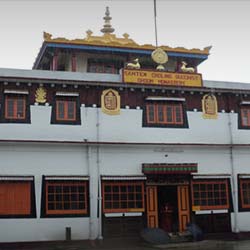
About Ghum Monastery Ghum Monastery, also known as Yiga Choeling Monastery, is a prominent Buddhist monastery located in Ghum, Darjeeling. It is one of the oldest Tibetan Buddhist monasteries in the region and holds great cultural and spiritual significance. The monastery is known for its stunning architecture and rich history, making it a popular tourist attraction in Darjeeling. History, Architecture and Design Ghum Monastery was established in 1850 by Lama Sherab Gyatso, a monk from Tibet. The monastery's architecture reflects traditional Tibetan design, with intricate paintings, sculptures, and prayer wheels adorning its walls. The main attraction of the monastery is a 15-foot high statue of Maitreya Buddha, believed to be one of the largest of its kind in the region. Best Time to Visit The best time to visit Ghum Monastery is during the months of March to May and September to November when the weather is pleasant and ideal for sightseeing. Avoid visiting during the monsoon season as heavy rainfall can disrupt your travel plans. Cultural Significance Ghum Monastery holds immense cultural significance for the Tibetan community in Darjeeling. It serves as a center for Buddhist teachings, meditation, and spiritual practices. The monastery also hosts various cultural events and festivals throughout the year, attracting devotees and tourists alike. Pilgrimage Practices Visitors to Ghum Monastery are encouraged to participate in the daily rituals and practices observed by the resident monks. This includes attending morning prayers, meditation sessions, and offerings to the Buddha. Pilgrims can also seek blessings from the monks and receive spiritual guidance during their visit. Dress Code and Etiquette When visiting Ghum Monastery, it is important to dress modestly and respectfully. Both men and women should wear clothing that covers their shoulders and knees out of respect for the Buddhist traditions. It is also customary to remove your shoes before entering the monastery and to maintain a quiet and respectful demeanor during your visit. Activities and Experiences Visitors to Ghum Monastery can partake in various activities and experiences, including guided tours of the monastery, attending meditation classes, and participating in cultural workshops. You can also explore the surrounding area on foot, taking in the serene beauty of the Himalayan landscape and interacting with the local community. Art and Religious Symbols The interior of Ghum Monastery is adorned with exquisite paintings, murals, and religious symbols that tell the story of Tibetan Buddhism. The intricate artwork and sculptures depict scenes from Buddhist mythology and teachings, creating a peaceful and meditative atmosphere for visitors. Local Insights For a deeper understanding of Ghum Monastery and its significance, consider engaging with the local community and monks. They can provide insights into the monastery's history, daily practices, and cultural traditions, giving you a unique perspective on Tibetan Buddhism and the spiritual life of the region.
Explore More